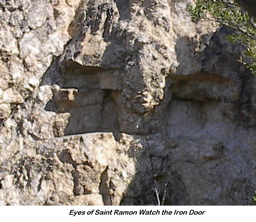|
AZentertain: Arizona Gold Rush The Search for the Lost Iron Door Mine of the Santa Catalinas
The legend of the lost Iron Door Mine of the Santa Catalina Mountains, north of Tucson, Arizona, is one of those stories that may have some base in fact and history. While tales of buried treasure in the Santa Catalinas have been told for generations, there have been no archaelogical excavations in the area beyond a small acerage to disprove the legends. However, there have been pieces of evidence and documentation to point to some possibilities that could have spawned the lost Iron Door mine legend. The Santa Catalinas have been prized by early American pioneers for its placer deposits of gold and silver, often found in ledges along the Canyon of Gold (Cañada del Oro). Part of the Iron Door Mine legend is that the early Spanish settlers in the late 1600s and early 1700s also discovered the hidden riches in the Catalina mountains.
During the late 1880s through the 1930s, countless newspaper articles in the Arizona newspapers publish stories of people who claim to have found either a lost city, the lost mine or other great treasures in the Santa Catalinas. Included in this report are links to the those articles. But, the exact location of either the lost city or lost mine with the Iron Door has never been fully disclosed or documented. Either it has never been found, or the secret has been taken to ones grave, or the secret has been passed on by word of mouth. Maybe a few might still know of its actual location. Claims of secret mining operations, a lost civilization that once inhabited the great Cañada del Oro basin, the gold rush of the 1800s and the famous Mine with the Iron Door book and movie still spur the imagination. The real hidden treasure may have already been discovered and carted off. But some remnants of this "rich mine" in the Catalinas may still be buried away. Some of the naturally occuring gold deposits may still be undiscovered. Today's technology can define once and for all whether the legends have any substance using metal detectors, ground penetrating radar, re-exploration of the area to unravel the mystery. There are actually two mysteries. The legend of the Lost City in the Santa Catalinas is in a different location from the lost mine, made famous during the 1920s as the Iron Door Mine. This page examines the Lost Mine legend. Some of legends name an Escalante who was an associate of Father Eusebio Kino, the missionary who founded Jesuit missions from Mexico through Arizona and California. This time period is about 1702. The legend says that the mine was located deep within the Santa Catarina mountains somewhere along the Cañada del Oro. Escalante worked this mine using the local natives as slaves in the mines. There was some type of settlement, a city, nearby that sustained the workers and also served as a mission. This may be the long, lost city of the Catalinas. The mine produced vast quantities of gold- much of which was taken to Spain. When the Jesuits were expelled in 1767, they left behind their riches. The bars of gold were hidden behind an "iron door." Thus, the Mine with the Iron Door. Areas deep in the interior of the Cañada del Oro basin, could have been in operation up until the time the Jesuits were expelled in 1767, or later, from Pimeria Alta- as this land was called by the Spanish. The U.S. Bureau of Mines conducted a mineral study of the Santa Catalina and Coronado National Forest and reported that:
1700s: The Escalante Mine is the Iron Door Mine
1880s: Rediscovering the lost mine
"Treasures of the Santa Catalina Mountains" is
|

